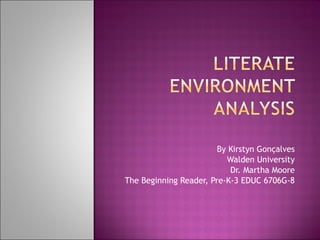
Literate environment analysis
- 1. By Kirstyn Gonçalves Walden University Dr. Martha Moore The Beginning Reader, Pre-K-3 EDUC 6706G-8
- 6. Learners Affective and cognitive aspects of literacy learning Texts Text structures, types, genres, and difficulty levels matched to literacy learners and literacy goals and objectives Instructional Practices Developmentally appropriate research-based practices used with appropriate texts to facilitate affective and cognitive aspects of literacy development in all learners Interactive Perspective Reading and writing accurately, fluently, and with comprehension Being strategic and metacognitive readers and writers Use a variety of informal and formal assessments to determine areas of strength and need in literacy development. Determine texts of the appropriate types and levels of difficulty to meet literacy goals and objectives for students. Use instructional methods that address the cognitive and affective needs of students and the demands of the particular text. Promote students’ independent use of reading strategies and skills.
- 7. Lesson Sequence : Vocabulary Lesson Introduction/Anticipatory Set For each text: -ask for any prior knowledge students might have -give any information that might provide background knowledge -write down vocabulary words that the students are to search for while reading Assessment -look for students who have a lot of prior knowledge about animals and vice versa -notice any students who already know what the vocabulary words mean and vice versa Building/Applying Knowledge and Skills -model thinking aloud while reading -ask many comprehension questions -allow students to read for the class -when students find a vocabulary word, model how to clarify the meaning by looking at the picture and by reading the words in the sentence and sentences around it to decipher the context Assessment - Note how many are participating in discussion and if their answers correlate to the selection. Synthesis/Closure For each text: -have students summarize the story -have students remind everyone what the vocabulary words mean -ask if there are any questions about the text or understanding new words Assessment -make sure to hear as many students summarize/retell the story and notice how well they do Extension/Enrichment/Transfer of Generalization of Knowledge: - vocabulary exercises -short paragraph of text with vocabulary words; complete the paragraph as a cloze activity using the words as context clues and the picture provided -match words with definition; for two words they must create their own definition
- 8. Learners Affective and cognitive aspects of literacy learning Texts Text structures, types, genres, and difficulty levels matched to literacy learners and literacy goals and objectives Instructional Practices Developmentally appropriate research-based practices used with appropriate texts to facilitate affective and cognitive aspects of literacy development in all learners Critical Perspective Judging, evaluating, and thinking critically about text Find out about ideas, issues, and problems that matter to students. Understand the learner as a unique individual. Select texts that provide opportunities for students to judge, evaluate, and think critically. Foster a critical stance by teaching students how to judge, evaluate, and think critically about texts. Response Perspective Reading, reacting, and responding to text in a variety of meaningful ways Find out about students’ interests and identities. Understand what matters to students and who they are as individuals. Select texts that connect to students’ identities and/or interests and that have the potential to evoke an emotional or personal response. Provide opportunities for students to read, react, and formulate a personal response to text.
- 9. Introduction/Anticipatory Set -Introduce students to the unit by showing them the matrix and explaining that they will be listening to the four books by Leo Lionni. -If desired, tell students a few details of Lionni’s life and work, especially that Leo Lionni was an artist before he was a writer -Show students the four books they will be listening to, and explain that they will compare the books by identifying things that are alike and different among the books. -Show students the cover of each book and ask for predictions about the story. Assessment As students retell their stories, listen for details and references to the literary elements that have been explored (character, etc.). Building/Applying Knowledge and Skills -Read the book aloud to students. While reading, model "thinking aloud" and questioning and predicting strategies. -Elicit student reactions to the text. Ask questions about the character, setting, problem, solution, and ending. Make sure students can retell the main parts of the story, especially details which will go into the cells of the matrix. -Move to the matrix. Ask students what animal is the main character in the story and what color it is. Write that information in the ‘character’ cell Assessment Monitor student progress during the lesson and as students work independently through anecdotal note taking and kid watching. Synthesis/Closure -Students work together in small groups to work on pictures for the matrix; each group will work on one drawing; you will do the writing for them on their drawings. -Break students into four groups and assign one element to each group: setting, problem, solution, ending. Have all students (as a whole group) agree first to what happened in the story, especially the problem/solution relationship, before students join their groups to do their drawings. -As students work, circulate and add sentences to their drawings with a black marker. -As the groups finish, glue their drawings on to the matrix. When all cells are filled in, have groups talk about their drawings, and retell the story together by reading the sentences on the drawings.